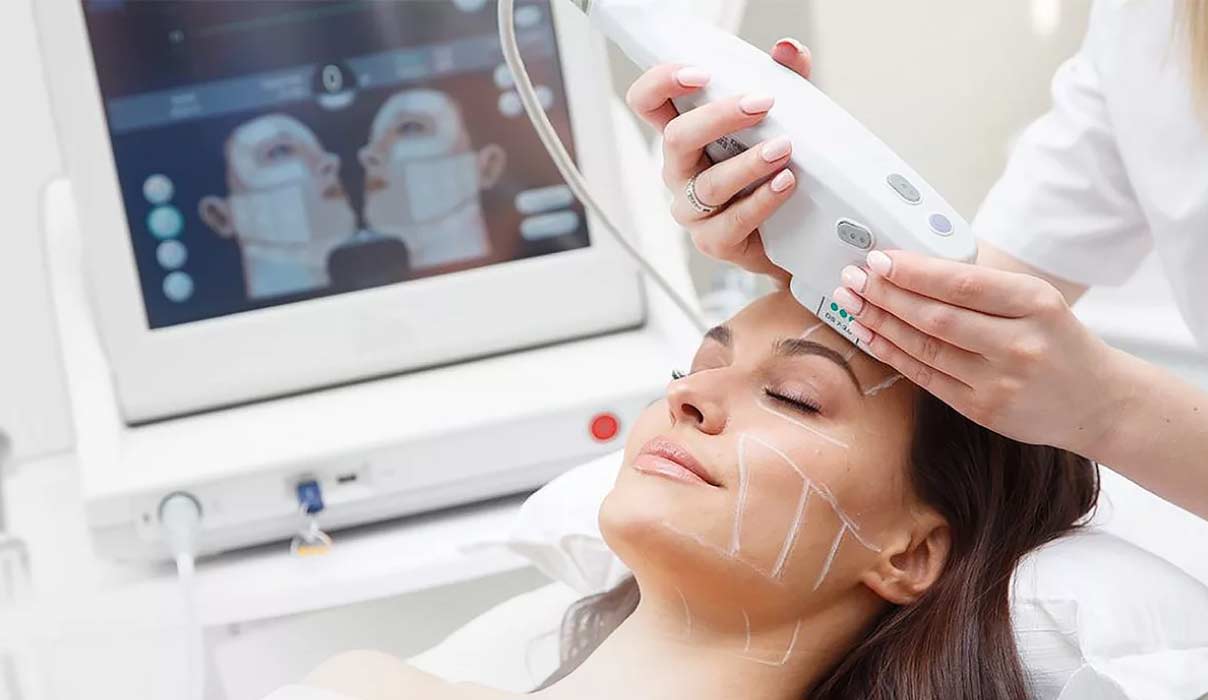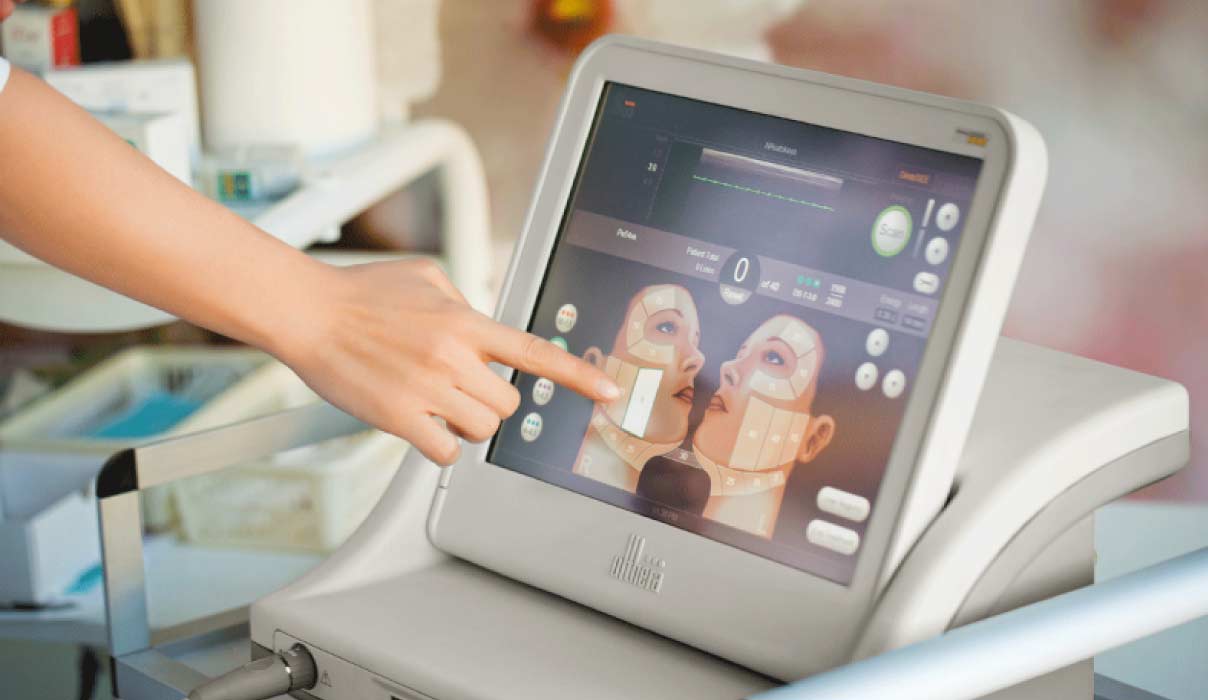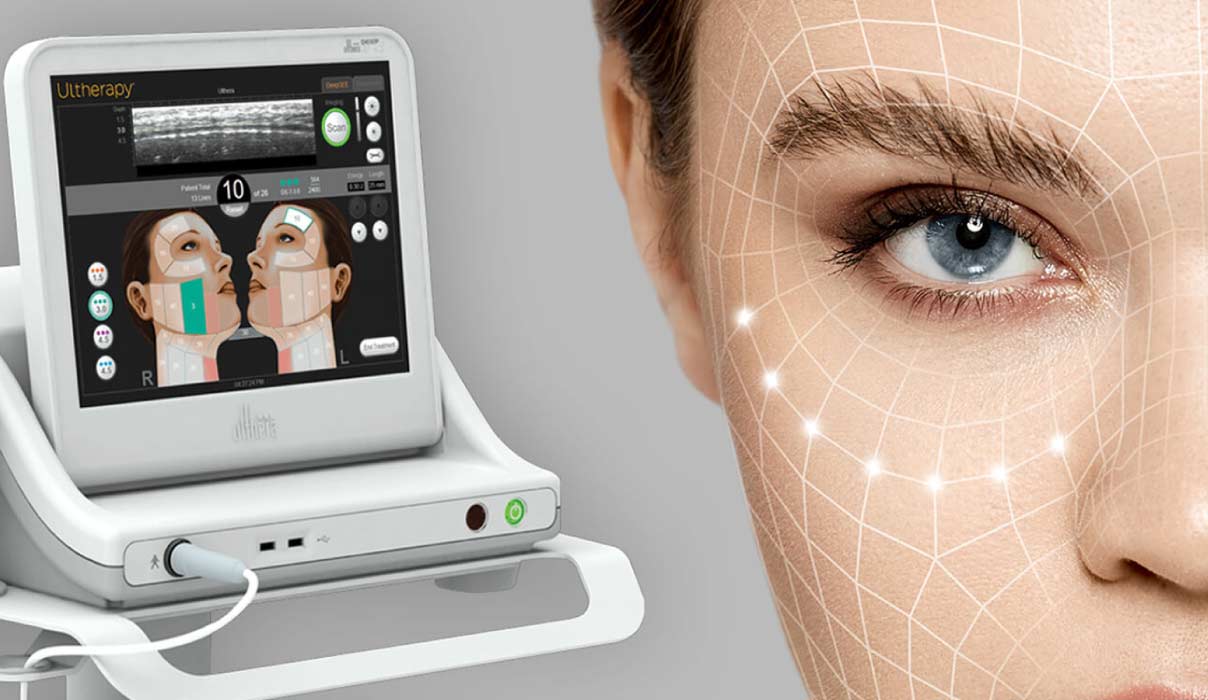Ultherapy is a non-surgical face-lifting procedure that uses focused ultrasound energy. Signs of aging, such as wrinkles, fine lines, and sagging, occur due to the stretching and weakening of collagen fibers. The function of Ultherapy is to shorten collagen fibers, making them effective and active once again. As a result, the skin appears tighter, smoother, and more vibrant. The person looks youthful and fit.
What is Ultherapy?

The procedure that eliminates signs of aging on the skin using High-Intensity Focused Ultrasound (HIFU) technology is called Ultherapy. Ulthera is a non-surgical treatment. It aims to increase collagen production by sending sound waves to the deeper layers of the skin. As the collagen tissues under the skin heat up due to the effect of the sound waves, they activate, prompting the skin to renew itself. As a result, the skin becomes healthier, higher quality, and youthful.
How Does the Skin Tighten with Ulthera?
Collagen fibers located in the deeper layers of the skin stretch over time and lose their functionality, a process we call aging. Due to aging, the skin loses its former brightness and vitality, leading to the formation of wrinkles, fine lines, and sagging.
Ulthera activates collagen structures using sound waves delivered to the skin’s deeper layers through HIFU technology, maintaining them at a temperature of 60º-70º. The heat releases the hydrogen bonds holding the collagen fibers, allowing the collagen to regain its former tightness. This also supports the process of Neocollagenesis, which promotes the production of new collagen. With the shortening of old collagen fibers and the increased production of new ones, the skin rejuvenates and gains a firmer appearance.
How Does Ulthera Work?
The Ulthera device transmits focused ultrasound energy to the dermis and SMAS layers of the skin. The SMAS layer is located 1.5-4 mm deep under the skin. The deeper layers of the skin undergo a bypass process (bridging) due to the high temperature, resulting in skin renewal.
The Ulthera device has different applicator heads chosen based on the skin thickness and the degree of deformation. The selection of a 1.5 mm, 3 mm, or 4 mm head is determined by the doctor according to the specific needs.
Who Is Ulthera Suitable For?
Ulthera is applied to individuals who are concerned about sagging, wrinkles, and fine lines in the face area. It is a good alternative for those who do not want to undergo surgery and exhibit mild to moderate levels of deformation. Additionally, the following conditions must be met for Ulthera treatment:
Ulthera is also performed not only to address existing deformations but also to prevent future signs of aging.
Ulthera Prices

The prices for Ulthera treatment may vary depending on factors such as the clinic, the treatment area, and the doctor’s expertise.
You can visit our center for an examination to determine if you are a suitable candidate for the Ulthera procedure and to receive detailed pricing information.
How Is Ulthera Performed?
After the treatment area is cleansed, gel is applied to the area where Ulthera will be performed. This gel allows the ultrasound waves to reach the deeper layers of the skin. The Ulthera applicator is moved over the gel, and shots are delivered. On average, 200 shots are performed on the chin area, 400 on the face, 600 on the face and neck, 900 on the face-neck-décolletage areas, and 100 shots around the eyes.
The shots using HIFU technology are planned in a controlled manner to deliver heat to the skin layers. A very mild discomfort may be felt during the shots. Once the procedure is finished, the treatment area is cleaned, and cream is applied. The Ulthera procedure takes approximately 25 minutes, depending on the size of the treated area.
What Is Done Before Ulthera?
The patient is first examined to determine if they are suitable for Ulthera, evaluating the degree of deformation and the treatment area. The region to be treated, the type of applicator, and the number of shots to be applied are planned. The patient’s medical history is reviewed to ensure there are no contraindications for Ulthera. After all assessments, if the doctor approves the procedure, the treatment begins.
What Should Be Considered After Ulthera?
Once the procedure is complete, the patient can immediately return to daily activities. There are no side effects such as redness, swelling, edema, bruising, or pain. However, the following points should be taken into consideration after Ulthera:
Which Areas Can Ulthera Be Applied To?
Ulthera is performed to reduce sagging and provide a tightening and lifting effect in the facial area. The most commonly treated facial areas include:
What Changes Occur in the Face After Ulthera?
The following changes can be observed after a full-face Ulthera treatment:
- The entire face becomes tighter, firmer, more vibrant, and radiant.
- Nasolabial folds disappear.
- The jawline becomes more defined.
- Wrinkles around the eyes vanish.
- The face takes on a more oval and sculpted appearance.
- The cheeks achieve a smooth texture.
- The double chin area reduces in size.
- The neck and décolletage appear more youthful.
What Are the Advantages of Ulthera?
The benefits and advantages of Ulthera include:
- It is performed without surgery, incisions, or general anesthesia.
- There is no pain or discomfort; the heat effect is felt at a minimal level.
- It easily and comfortably addresses mild to moderate skin deformities.
- The treatment is completed in a single session.
- It provides fast results with no recovery time.
- It is more cost-effective compared to surgical facelift procedures.
When Do Ulthera Results Start to Show?

The effects of Ulthera are noticeable immediately after the procedure. However, it takes 3 to 6 months for the full effect to be achieved as the collagen tissues become fully activated. The duration and extent of Ulthera’s impact may vary depending on each individual’s physiological characteristics.
How Long Does the Effect of Ulthera Last?
The effects of Ulthera typically last for about 2 years. Once the effect period ends, the signs of aging gradually reappear. Ulthera is a repeatable procedure.
Does Ulthera Have Any Side Effects?
Although Ulthera is applied externally to the skin, it does not damage the outermost layer (epidermis). No cuts, wounds, or injuries occur on the skin. The Ulthera device used in our center is FDA-approved. When performed by experienced and skilled doctors, Ulthera is a safe and risk-free procedure.
Does HIFU (Ulthera) Cause Fat Loss in the Face?
HIFU (Ulthera) can be applied to various areas. When used in fatty regions such as under the chin or the double chin area, it helps break down fat and tighten the skin. Once the full effect of HIFU is achieved, the result is firm, smooth, and tight skin.
Does Ulthera Hurt?
Ulthera is a painless procedure. There are no injections or incisions made during the treatment. However, individuals with a low pain threshold may feel slight sensations of heat or tingling due to the high temperature. These effects are minimal and do not require pain medication.
Does Ulthera Leave Scars?
Ulthera does not involve incisions or stitches, so it does not leave scars. It is a comfortable procedure, with no redness, bruising, or swelling afterward.
![dr.leyla-arvas-800×1000.jpg[1] dr.leyla arvas](https://www.quartz.com.tr/wp-content/uploads/2024/11/dr.leyla-arvas-800x1000.jpg1_.webp)
Author : Op. Dr Leyla ARVAS
Dr Leyla Arvas is an internationally recognised specialist in aesthetic surgery based in Istanbul. Graduated in 1998 from Istanbul University Faculty of Medicine, she has developed her expertise by studying in Taiwan, Japan and Spain during her 20 years of experience.
This article April 19, 2025 was updated on
Editor: admin@quartz.com.tr


